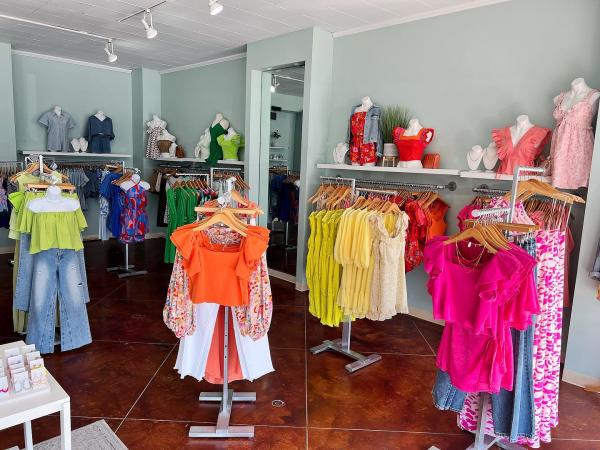Exactly how to Style Your Clothing with Boutique Fashion Finds
Exactly how to Style Your Clothing with Boutique Fashion Finds
Blog Article
Lasting Fashion: How Eco-Friendly Clothes Is Forming the Future of Design
As the garment industry encounters raising examination over its ecological impact, the rise of lasting style offers an encouraging alternative that aligns style with eco-friendly responsibility. Employing innovative materials such as plant-based textiles and recycled fibers, along with innovative approaches like digital and 3D printing, developers are redefining what it implies to be stylish in the contemporary age. Simultaneously, the expanding popularity of upcycling and second hand culture is cultivating a shift in the direction of a circular economic situation. Just how does this motion really influence the future trajectory of style, and what obstacles lie in advance in its widespread fostering?
Ingenious Sustainable Products
As the style industry grapples with its ecological influence, ingenious lasting materials have arised as a vital option for minimizing ecological impacts. These products not only minimize dependence on fossil fuels but also lessen dangerous chemical usage and water usage.
Along with plant-based materials, innovations in biofabrication have actually brought about the growth of lab-grown fabrics. Mycelium natural leather, stemmed from mushroom origins, offers a versatile and naturally degradable alternative to animal leather. Its production causes substantially lower carbon discharges and water use, making it a more sustainable choice for fashion developers looking for to line up with eco-friendly methods.
Recycled products are likewise obtaining grip, with polyester made from recycled plastic bottles standing for a significant advancement. This innovation not just diverts plastic waste from seas and landfills however also reduces power intake contrasted to producing virgin polyester. With each other, these materials emphasize the capacity for a more lasting garment industry, leading the way for environmentally aware design and production.
Eco-Conscious Manufacturing
Building on the advancements in lasting materials, the fashion business is also re-evaluating its production procedures to further lower environmental effect. Key strategies consist of minimizing water usage, decreasing carbon exhausts, and removing hazardous chemicals. By embracing closed-loop systems, producers intend to reuse water and energy efficiently, substantially lessening waste. The assimilation of eco-friendly power resources, such as solar and wind power, right into manufacturing centers better reduces dependence on nonrenewable fuel sources.
Another important element is the reduction of hazardous chemicals generally used in coloring and completing textiles. Eco-conscious producers are changing towards plant-based dyes and waterless dyeing innovations, which not only safeguard local environments but likewise enhance employee safety. Technologies like digital printing minimize fabric waste and power usage, using a cleaner option to conventional methods.
With the development of blockchain modern technology, business can currently give thorough insights right into their supply chains, guaranteeing ethical and eco friendly methods at each action. As the demand for eco-conscious products expands, manufacturers are forced to introduce, guaranteeing that the future of fashion is both lasting and fashionable.
The Increase of Upcycling
Upcycling, a transformative practice in lasting fashion, entails artistically repurposing thrown out products right into brand-new, top notch items. This ingenious strategy not just minimizes waste yet additionally diminishes the need for basic materials, consequently lessening the environmental influence of clothes manufacturing. By reimagining and rebuilding existing items, designers and style brand names are able to infuse originality right into their collections while promoting ecological duty.

Furthermore, the upcycling motion has actually encouraged small companies and independent developers, that commonly lead in advancement due to their agility and creativity. By exploiting on the plentiful availability of extra materials, these entities contribute to a circular economy, demonstrating that fashion can be both sustainable and trendy. Via upcycling, the sector takes considerable strides towards an extra responsible and conscious future.
Thrift Society's Impact
The blossoming thrift culture dramatically reshapes the landscape of sustainable fashion, emphasizing the significance of mindful intake. This social shift motivates customers to welcome used clothing, consequently reducing the demand for new garment manufacturing and lessening ecological influence. Thrift shopping not just extends the lifecycle of apparel yet also reduces the carbon footprint connected with manufacturing, carrying, and throwing away clothing.
An essential aspect of thrift culture is its democratization of style. By using a broad range of designs from different periods at inexpensive rates, second hand stores make style available to a wider audience. This access cultivates a sense of uniqueness and creative thinking, as customers mix and that site suit one-of-a-kind pieces to curate tailored wardrobes without adding to the fast fashion cycle.
Moreover, thrift society promotes circularity in fashion, lining up with the concepts of a circular economic climate. As more customers and developers embrace second hand culture, the style market is forced to adapt, integrating lasting techniques to meet the expanding demand for eco-conscious choices.

Future Trends in vogue
Style's development is progressively shaped by technological technologies and sustainability-driven initiatives. As consumers come to be much more ecologically aware, the market is reacting with groundbreaking advancements that redefine the future of design. One noticeable fad is the surge of digital style, where online garments can be worn in augmented reality atmospheres, substantially decreasing material waste. This change not just accommodates the digital-savvy customer however additionally minimizes the ecological footprint commonly connected with garment production.
Additionally, the assimilation of blockchain innovation supplies new possibilities in transparency and traceability, permitting customers to verify the sustainability credentials of their apparel. boutique fashion. This makes certain liability in supply chains and promotes honest sourcing methods. 3D click now printing is yet one more technology that assures to revolutionize manufacturing procedures by enabling on-demand production, therefore lowering excess stock and waste
Additionally, the advancement of bio-fabricated products, such as lab-grown leather and plant-based fabrics, provides lasting choices to conventional materials. These innovations decrease dependence on animal items and resource-intensive plants. As these technologies grow, they are positioned to transform the fashion landscape, combining style with sustainability. The future of style, as a result, hinges on a seamless mix of technology, development, and environmental responsibility.
Conclusion
The makeover of the style sector through sustainable techniques suggests a crucial shift in the direction of environmental accountability. This evolution not just straightens fashion with environmental sustainability but likewise sets a criterion for future trends concentrated on responsibility and technology.
As the fashion sector deals with enhancing examination over its environmental influence, the surge of sustainable fashion provides a promising alternative that lines up style with eco-friendly duty.As the fashion sector grapples with its ecological effect, ingenious sustainable materials have actually arised as an important solution for reducing ecological impacts. With each other, these materials highlight the capacity for a more lasting fashion industry, paving the means for environmentally conscious design and production.
Structure on the technologies in sustainable products, the style sector is additionally re-evaluating its production processes to additionally reduce ecological influence. boutique fashion.Upcycling, a transformative technique in lasting style, involves artistically these details repurposing thrown out materials right into new, high-grade products
Report this page